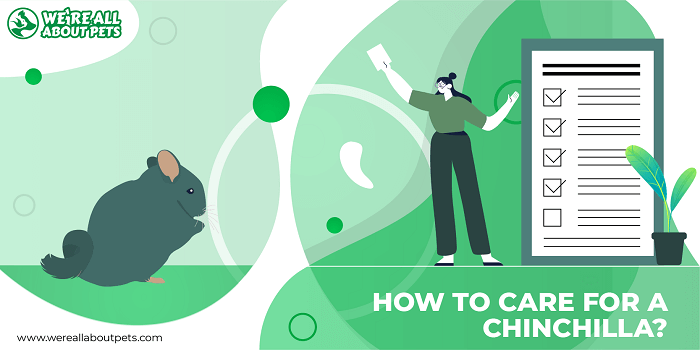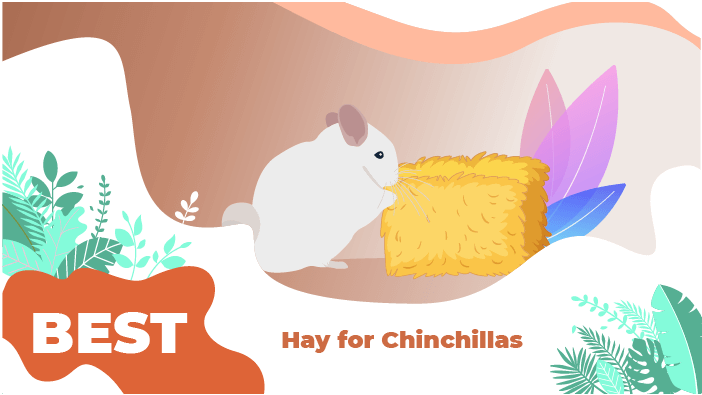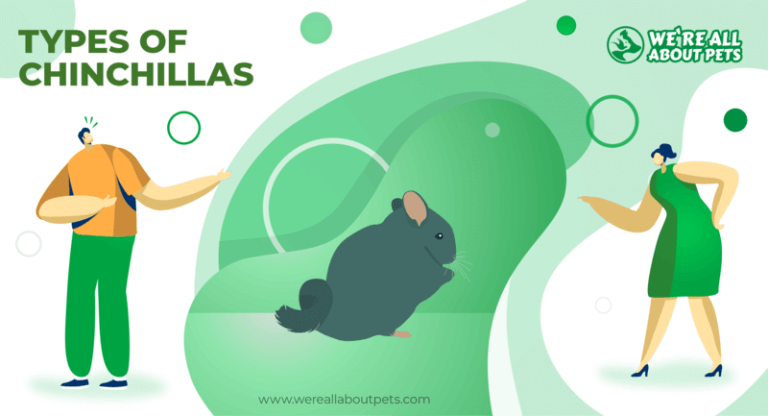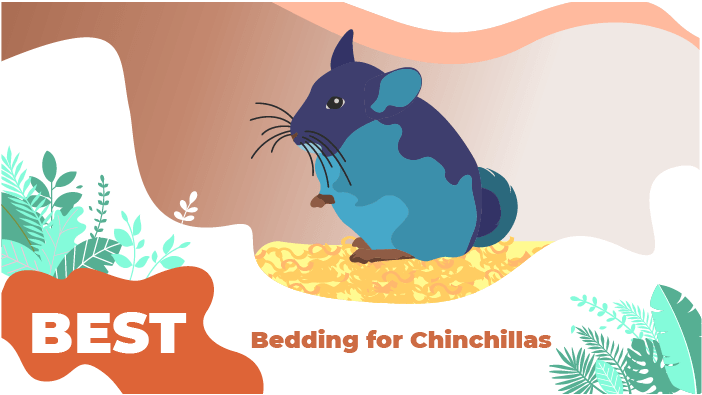How To Care For A Chinchilla?
This page contains affiliate links. We may earn money or products from the companies mentioned in this post through our independently chosen links, which earn us a commission. Learn More
General Stats:
- Pet Type: Small pet
- Size: 10 to 14 inches
- Diet: Herbivore
- Lifespan: About 10 years
When you picture a chinchilla, you probably imagine a small fluffy pet with big ears and a bushy tail. Cute and cuddly as chinchillas may be, they can also be quite a handful at times.
These pets are naturally inquisitive by nature and they can be pretty energetic as well.
The chinchilla is not necessarily the most difficult pet to care for, but there are certain things you need to know before you choose this pet. Chincillas are unique and if you’re not prepared to handle the responsibility, your new pet may not get the quality care he deserves.
Here’s what you need to know about proper care for a pet chinchilla.
Habitat Setup For Chinchillas
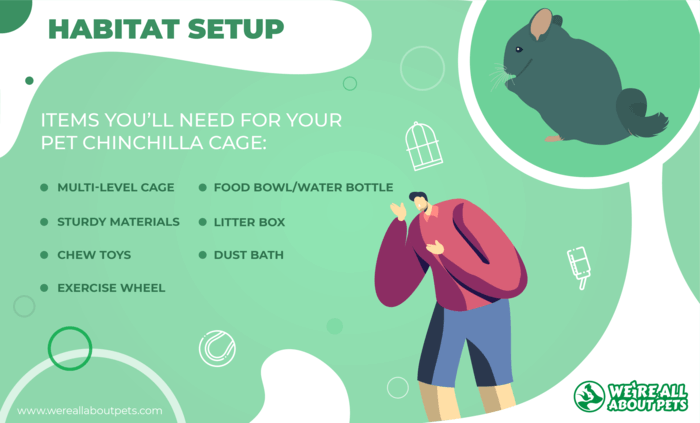
Though chinchillas may be small animals, they are very active and require a significant amount of space. The best cage for a chinchilla has multiple levels and is made from heavy-duty materials. It should be easy to access for cleaning with a solid bottom.
Here are some of the items you’ll need for your pet chinchilla cage:
- Multi-Level Cage – A chinchilla cage should be at least 3x2x2 feet for a single adult. If you keep more than one, provide at least 2 square feet of floor space each and choose a multi-level cage.
- Sturdy Materials – The cage should be made from sturdy materials with a solid bottom – do not use a wire-bottom cage for a chinchilla.
- Chew Toys – Chinchillas have twenty teeth that grow continuously, so they need plenty of chew toys to keep them worn down. The best chinchilla toys are made from natural wood to encourage chewing.
- Exercise Wheel – The chinchilla is a very active pet, so you should provide a wheel so your pet can get its exercise. Providing a multi-level cage with plenty of playtime out of the cage may work too.
- Litter Box – You can easily train your chinchilla to use a litter box, particularly for urine. You’ll just need a litter box and some shavings to fill it with.
- Food Bowl/Water Bottle – When it comes to a chinchilla food bowl, look for something that won’t tip over easy and can’t be chewed on. Choose a water bottle rather than a water bowl because a bowl might get your pet’s fur wet.
- Dust Bath – Chinchillas bathe in dust rather than water, so you’ll need a box and some chinchilla dust for your pet to use on a weekly basis.
When setting up your chinchilla’s cage, it’s important to think about placement. Keep the cage out of direct sunlight and make sure to keep it in an area that won’t be too drafty or too warm. Chinchillas should not be kept above 80 degrees Fahrenheit.
You can choose whether to use bedding in your chinchilla cage or to simply line it with fleece. Bedding like wood shavings or Carefresh absorbs liquid and odor but you’ll need to replace it fairly often. If you want to limit the mess, train your pet to use a litter box.
Chinchilla Diet
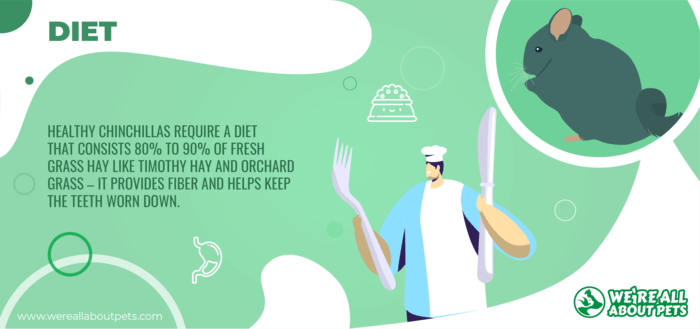
The chinchilla is an herbivorous animal by nature. A natural chinchilla diet consists primarily of plants and grasses, being high in fiber and protein with limited fat and moisture. You should also include a high-quality chinchilla pellet in your pet’s daily diet.
Here are some quick facts about the ideal chinchilla diet:
- Healthy chinchillas require a diet that consists 80% to 90% of fresh grass hay like timothy hay and orchard grass – it provides fiber and helps keep the teeth worn down.
- Avoid feeding your chinchilla high-fat foods like seeds and nuts as well as starchy food like corn.
- You can offer very small amounts of dried fruit as treats but they are high in sugar so they shouldn’t be part of the daily diet.
- Feed your chinchilla small amounts of fresh vegetables and herbs on a daily basis – they really only need about a teaspoon or two per day.
- Commercial chinchilla pellets should be offered in small amounts to ensure your pet gets the right balance of essential nutrients.
In addition to food, be sure to provide your pet with unlimited access to fresh water as well. A small pet water bottle is perfectly adequate. Just be sure to clean it and refill it on a daily basis.
Also Read: What Do Chinchillas Eat?
Chinchilla Veterinary Care
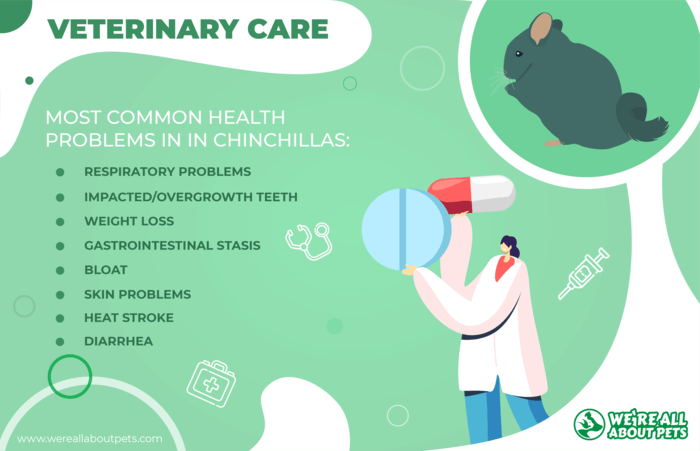
If you follow the advice in any chinchilla care guide, you can expect to enjoy your pet’s company for 10 years or more.
Even with proper care of a chinchilla, however, your pet could develop health issues which may require veterinary attention. It’s important to locate an exotics vet in your area so you know where to take your chinchilla if a problem arises.
Here are some of the most common health problems in chinchillas:
- Respiratory problems
- Impacted/overgrowth teeth
- Weight loss
- Gastrointestinal stasis
- Bloat
- Skin problems
- Heat stroke
- Diarrhea
Remember, not all veterinarians are trained to care for small pets like chinchillas.
Look for an exotics vet and take your new pet in within a few weeks of bringing him home. Your chinchilla doesn’t need any vaccinations, but he should get an annual checkup to keep an eye on his health.
Many pet owners consider buying pet insurance to help offset the costs of veterinary care, but it’s unlikely to be worth the cost for a chinchilla.
Pet insurance requires you to pay a monthly premium in exchange for coverage.
The trouble is many plans don’t cover exotic pets and chinchillas don’t require a lot of ongoing care. You may end up spending more in premiums than you would to pay for the treatment itself. Consider putting that money in savings instead so you have it in case of an emergency.
Chinchilla Fun Facts
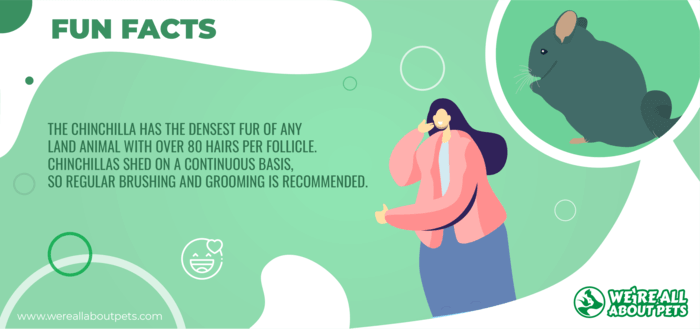
- The chinchilla has the densest fur of any land animal with over 80 hairs per follicle. Chinchillas shed on a continuous basis, so regular brushing and grooming is recommended.
- Chinchillas have 20 teeth from birth, including 4 incisors and 16 molars. Your chinchilla’s teeth are open-rooted which means they grow continuously – your pet needs plenty of hay to keep them worn down.
- The chinchilla is a nocturnal and crepuscular animal. This means they tend to sleep during the day but may also be active near dusk and dawn.
- Chinchillas typically have 2 to 3 litters of kits per year with 2 to 4 kits each time. The gestation period for chinchillas is fairly long as well, about 110 days.
- The chinchilla is an herbivorous animal and the majority of its diet should consist of roughage – fresh hay. Not only does the hay provide fiber but it also helps keep the teeth worn down.
- Chinchillas and water simply don’t mix which is why they prefer to take dust baths. A chinchilla’s fur is very thick, so it dries very slowly, and the dampness increases the risk for fungal infection.
While the chinchilla makes an excellent pet, it may not be the perfect choice for everyone. These animals live for an average of 10 years or more and they have unique requirements in terms of diet and hygiene.
Take what you’ve learned here to make sure you can care for a chinchilla before you bring one into your life and into your home.
Frequently Asked Questions
How long do chinchillas live?
The average lifespan for a pet chinchilla is about 10 years. In captivity, these pets can live longer, however, sometimes up to 15 years or more.
How much do chinchillas cost?
The chinchilla is not quite as expensive to keep as a dog or cat, but you’ll make a significant upfront investment when it comes to buying the pet and its habitat. You should expect to spend between $75 and $150 on the chinchilla alone and an additional $100 to $300 on the cage. The average cost to get started with a chinchilla is over $200 and up to $750.
How big do chinchillas get?
The average chinchilla grows about 9 to 10 inches long with an additional 3 to 6 inches of tail length. Chinchillas generally weigh 1 to 2 pounds.
What do chinchillas eat?
The chinchilla is an herbivorous animal, so about 80% to 90% of its diet should come from high-quality grass hay. Commercial chinchilla pellets are recommended as well to provide the right balance of nutrients with occasional fresh food as treats.
Are chinchillas good pets?
The chinchilla is a curious, friendly pet that has the ability to bond with its owner, but they can also be fairly skittish and generally don’t like to be held. If you’re looking for an entertaining pet and you’re able to provide for your chinchilla’s needs, however, they make very good pets.
Are chinchillas messy?
Chinchillas are fairly clean animals in terms of their own personal hygiene. These animals spend a good deal of time grooming themselves and they need a regular dust bath to keep themselves clean and healthy. That being said, chinchillas can get a little messy when they feel frustrated. For the most part, however, their cages don’t tend to smell – especially if you use fresh shavings and clean it frequently. A weekly chinchilla dust bath will also help keep your pet clean.
Where do chinchillas come from?
The chinchilla is a large rodent native to the Andes Mountains in northern Chile, South America.
Do chinchillas bite?
Chinchillas are fairly gentle, but they aren’t necessarily the cuddliest pets. With proper handling you shouldn’t have to worry about your chinchilla biting you, but any animal will bite if it feels threatened.
Do chinchillas sleep?
The chinchilla is a nocturnal animal and also crepuscular. This means that your chinchilla will sleep during the day instead of at night and that he’s most likely to be active at dawn and dusk.
How long are chinchillas pregnant for?
Chinchillas have surprisingly long gestation periods around 110 days. The average litter is 2 kits, though chinchillas can have up to 4, and females usually have 1 to 3 litters per year.






